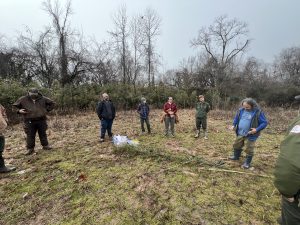
A team from The University of Alabama and Alabama Water Institute’s CONSERVE research group recently spent a productive week working with the United Keetoowah Band of Cherokee Indians in Tahlequah, Oklahoma. Their goal was to observe and understand native rivercane populations — a plant species that is important to the watersheds and cultural lifeways of Southeastern Indigenous communities.
“The teaming up of scientific research and Indigenous knowledge systems through the partnership of the UKB in Oklahoma with UA CONSERVE will change the misperceptions of rivercane ecosystems and what they have to offer for modernity and the environment,” said Roger Cain, UKB tribal historic preservation officer.

CONSERVE director Michael Fedoroff and Dr. Michael McKain, CONSERVE assistant director of watershed biodiversity, were hosted by the UKB along with the United States Army Corps of Engineers Tribal Nations Technical Center of Expertise, the USACE Tulsa District and the U.S. Fish and Wildlife Service to exchange information on rivercane needs and management on the Sequoyah Wildlife Refuge.
McKain and Fedoroff secured research funding from the USACE Sustainable Rivers Program to research and develop a rivercane genome to better understand and conserve this important species. Part of this visit allowed the CONSERVE team to train UKB tribal staff and federal agency partners in the proper techniques of collecting DNA samples from rivercane populations across the area.

“The collaborative work between UKB and UA CONSERVE is representative of how powerful the melding of traditional ecological knowledge and genomics techniques can be,” said McKain. “Our efforts are helping to protect a cultural resource while laying a foundation for promoting re-establishment of a vital ecosystem of the American South. This flagship project embodies our goals of working with the needs of people and of nature to find solutions to environmental problems.”
Through meaningful partnerships with tribal governments, federal agencies and other non-profits, CONSERVE is at the forefront of actionable water science to conservation work in the Southeast.
“The UA CONSERVE research group provides specialized expertise and enhances valuable relationships with tribes and other universities for this USACE Sustainable Rivers Program rivercane project,” said Brian Zettle, USACE TNTCX project manager.
For more stories and to follow this and other projects, visit the CONSERVE research group website.